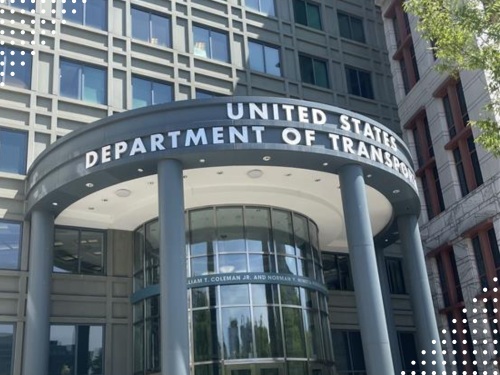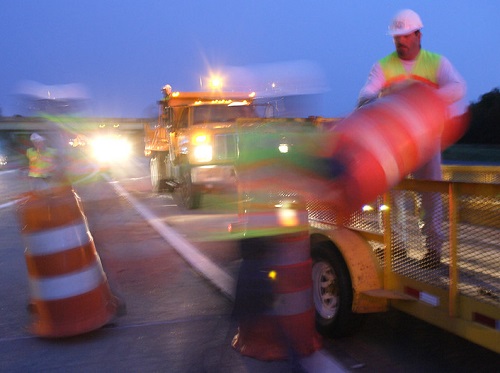A recent blog post by the Transportation Research Board re-emphasizes that “much more work” needs to be done in terms of detailed research, planning, and technology usage to make highway work zones safer for construction personnel and motorists alike.
[Above photo by the Virginia DOT]
“You expect people to drive slowly in work zones,” noted Julius Codjoe, special studies research administrator at the Louisiana Department of Transportation and Development and a TRB volunteer.

“However, drivers unexpectedly coming upon slow or stopped traffic [are] usually the cause for crashes in work zones,” he said.
“We know the more unexpected traffic queues you have, the more safety issues that are going to come up,” Codjoe added.
The issue of work zone safety came into stark relief on March 22 when a crash on the inner loop of Interstate 695 in Maryland, known as the Baltimore Beltway, cost the lives of six highway workers. Maryland Governor Wes Moore (D) had state flags lowered to half-mast until sunset on March 24 in their memory.
“My prayers continue to be with the families and loved ones of the six construction workers who tragically died while on the job,” the governor said in a statement. “We honor them and their service to Maryland.”

Members of Congress and witnesses at a March 28 transportation and infrastructure hearing on Capitol Hill also expressed their sympathies to the families of those six fallen highway workers as well.
“This tragic situation underscores the need to ensure the safety of all roadway users, including construction workers who are simply trying to do their job and help improve America’s infrastructure,” noted Rep. Rick Crawford (R-AR) chairman of the highways and transit subcommittee, in his opening remarks at the hearing.
“We extend our condolences to their families,” added Marc Williams, executive director of the Texas Department of Transportation.

[Editor’s note: The annual National Work Zone Awareness Week campaign is held every spring to coincide with the start of construction season to encourage safe driving through highway work zones. Click here to learn more about the 2023 NWZAW campaign and the campaign kick-off event that Missouri Department of Transportation will host. And click here to learn about the recent joint bipartisan resolution issued to recognize April 17 through April 21 as “National Work Zone Awareness Week” for 2023.]
One of the resources available to state departments of transportation to alleviate that issue is the Highway Capacity Manual or HCM, Codjoe pointed out, which provides state DOTs with ways to calculate roadway capacity and thereby determine where traffic queues could form.

“Accurately determining this will allow agencies to warn unsuspecting drivers and thereby avoid work zone crashes,” he said, adding that the most recent edition of the HCM was released in early 2022.
“What we’ve learned is that, ultimately, heavy vehicle percentages make the biggest difference in capacity of the roadway,” Codjoe emphasized. “The formulas we were using were right, but they were off for heavy vehicles. You can have the most complicated model you want, but if your input volumes are wrong, you’re not going to get the right outcomes.”
One way to improve work zone safety is through the use of transportation management plans, said TRB.

For example, the National Cooperative Highway Research Program recently issued a new resource – Strategies for Work Zone Transportation Management Plans – that offers insight on how to select and implement strategies that improve safety and traffic operations in roadway construction work zones.
Another NCHRP resource cited by TRB is Use of Safety Management Systems in Managing Highway Maintenance Worker Safety – a compendium of the current work zone safety strategies deployed by Connecticut, Nevada, Tennessee, Texas, and Virginia.
Several other research efforts separate from TRB are also definitively defining ways to improve highway work zone safety.

For example, two recent field studies conducted by the AAA Foundation for Traffic Safety examined the effectiveness of certain “countermeasures” that aim to reduce highway work zone crashes – especially vehicle-mounted electronic variable message signs or VMSs, which were found to be highly effective in reducing highway work zone crashes.
Meanwhile, a recent study completed by the University of Missouri found that using a self-driving truck to follow a crewed vehicle has the potential to reduce worker injuries in highway work zones.
That research found that truck-mounted “crash cushions,” known as truck mounted attenuators or TMAs, positioned at the end of mobile work zones to absorb the impact of a potential crash.
The University of Missouri’s study found, though, if the vehicle equipped with the TMA is a self-driving truck, more injuries could be avoided.

To that end, the Colorado Department of Transportation plans to use a recently-awarded $1.9 million federal grant from the U.S. Department of Transportation to expand the ways it’s been using such self-driving trucks to protect workers in construction zones.
“For the men and women working as highway maintainers and in our work zones, Colorado’s roads are their office,” said Colorado DOT Executive Director Shoshana Lew in a statement. “Innovations such as automated attenuators can be life-saving.”
 Top Stories
Top Stories
USDOT Makes $1.5B Worth of BUILD Grants Available
December 19, 2025 Top Stories
Top Stories

